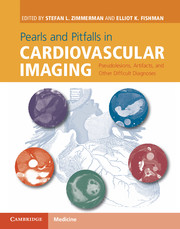 Pearls and Pitfalls in Cardiovascular Imaging
Pearls and Pitfalls in Cardiovascular Imaging from Section 4 - Coronary arteries
Published online by Cambridge University Press: 05 June 2015
Imaging description
Respiratory motion and heart rate variability are two of the primary causes for image artifacts on a gated thoracic computed tomographic angiography (CTA). Respiratory motion artifacts affect both the heart and adjacent structures, such as the sternum anteriorly and the descending aorta posteriorly (Figures 28.1 and 28.2), and are best identified using sagittal multiplanar reformats (MPRs). On sagittal MPRs, respiratory motion will cause stair-step artifacts and discontinuity of the sternum, aorta, and cardiac chambers. Blurring of lung parenchyma will also be visible on axial images in lung windows. Coronary segments may appear blurred or absent altogether (Figure 28.3). Cardiac gating artifacts can be distinguished from respiratory motion as they only affect the heart (Figure 28.4); no sternal discontinuity will result on sagittal MPRs. The appearance of cardiac gating artifacts will vary depending on whether the study is being acquired with prospective triggering or retrospective gating. With prospective triggering, the stair-step or stepladder artifact may occur due to heart rate irregularity or arrhythmias resulting in capture of a different segment of the heart than is desired. With retrospective gating in combination with tube current modulation, gating artifacts may result in stair-step artifacts combined with a band of noisy data being reconstructed (Figure 28.5).
Importance
Obtaining a diagnostic coronary CTA depends on heart rate optimization and the patient's ability to breath-hold during the image acquisition. In the absence of one or both of these factors, the resulting artifacts may lead to suboptimal evaluation or even complete non-visualization of certain coronary segments. Effective protocoling of a coronary CTA should include assessment of the patient's heart rate and breathing, and implementation of necessary interventions, such as beta blockade, to decrease high heart rates or accommodate known arrhythmias. The ability to successfully acquire a diagnostic gated thoracic CTA examination can be affected by irregular heart rates or arrhythmias such as atrial fibrillation.
To save this book to your Kindle, first ensure [email protected] is added to your Approved Personal Document E-mail List under your Personal Document Settings on the Manage Your Content and Devices page of your Amazon account. Then enter the ‘name’ part of your Kindle email address below. Find out more about saving to your Kindle.
Note you can select to save to either the @free.kindle.com or @kindle.com variations. ‘@free.kindle.com’ emails are free but can only be saved to your device when it is connected to wi-fi. ‘@kindle.com’ emails can be delivered even when you are not connected to wi-fi, but note that service fees apply.
Find out more about the Kindle Personal Document Service.
To save content items to your account, please confirm that you agree to abide by our usage policies. If this is the first time you use this feature, you will be asked to authorise Cambridge Core to connect with your account. Find out more about saving content to Dropbox.
To save content items to your account, please confirm that you agree to abide by our usage policies. If this is the first time you use this feature, you will be asked to authorise Cambridge Core to connect with your account. Find out more about saving content to Google Drive.